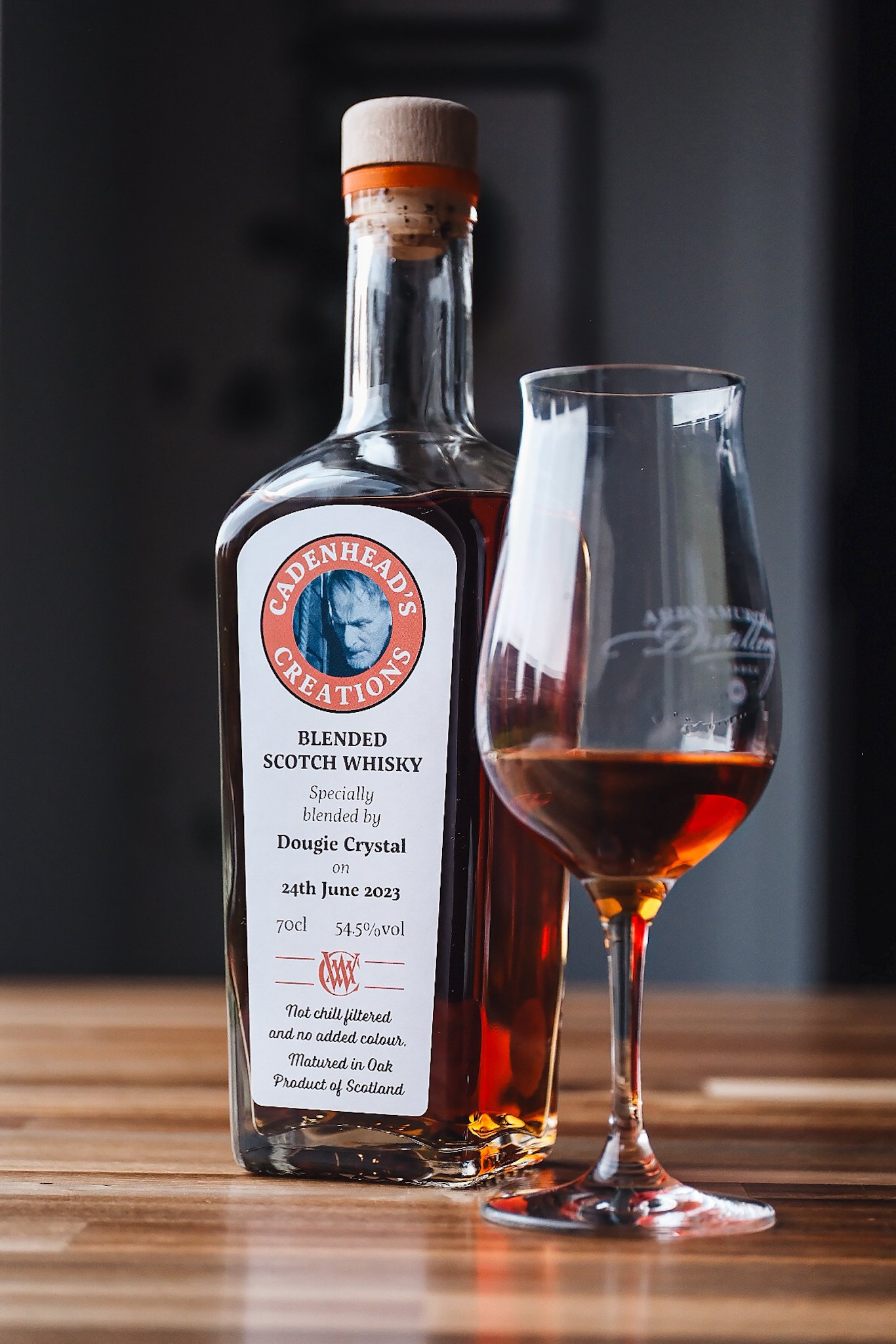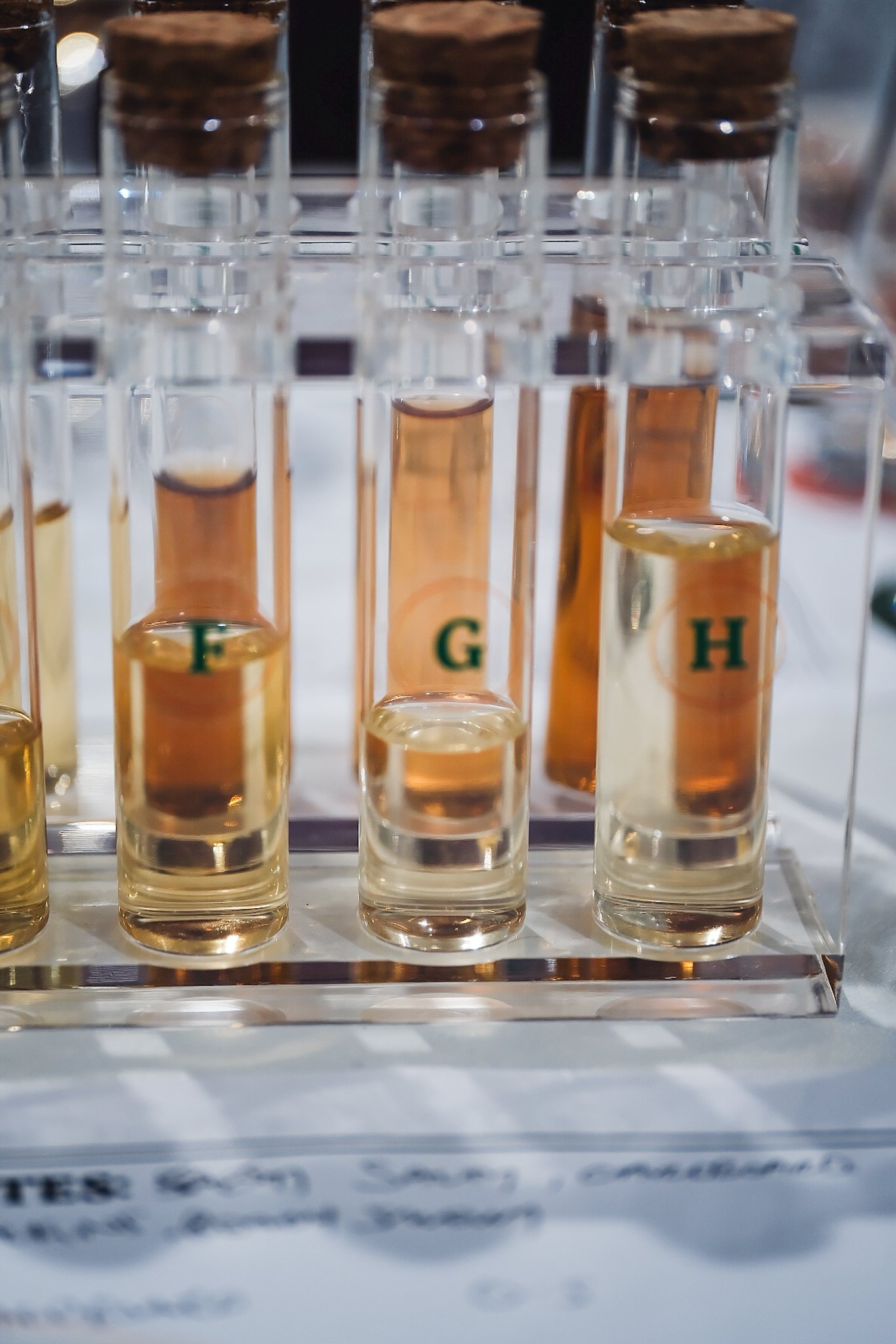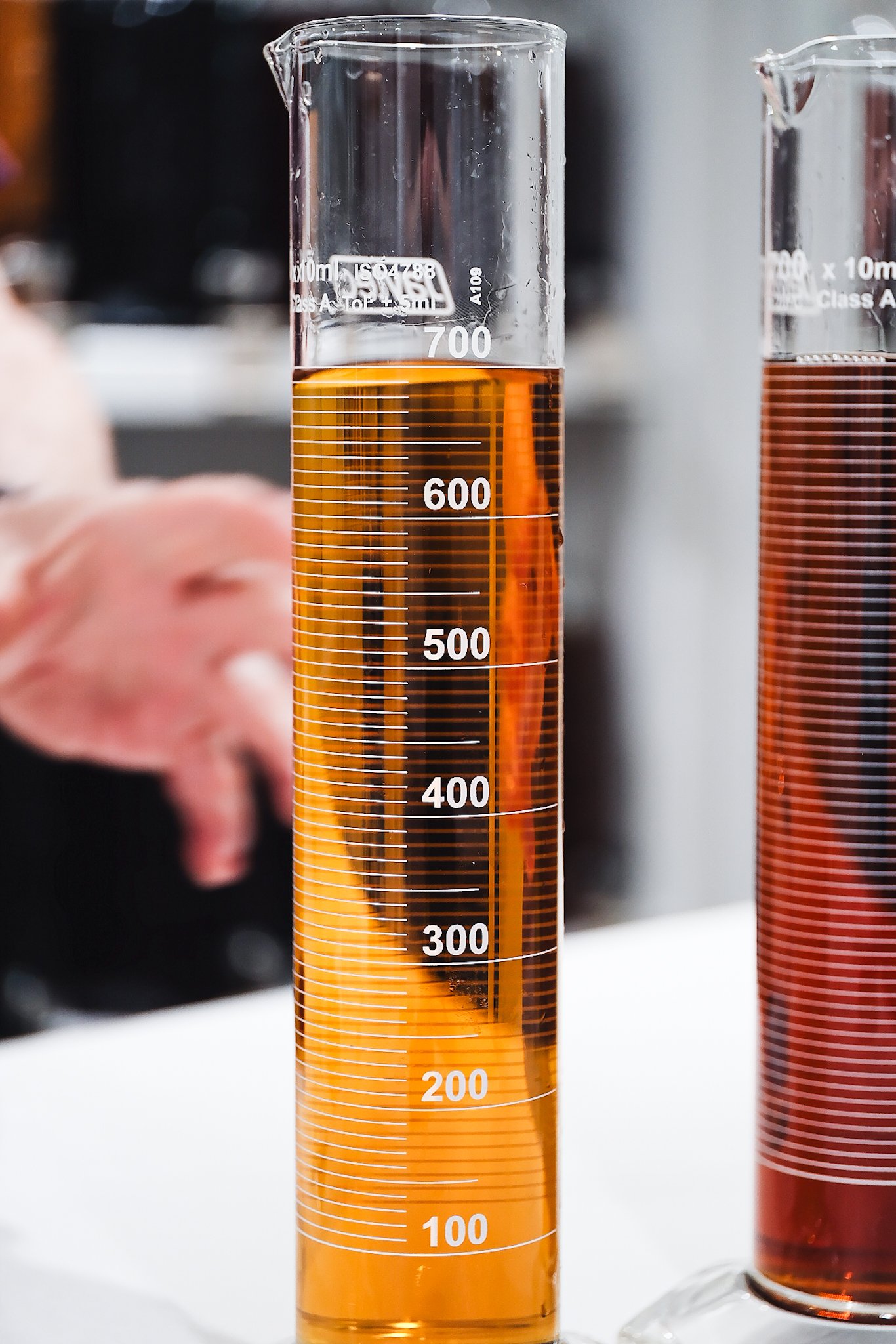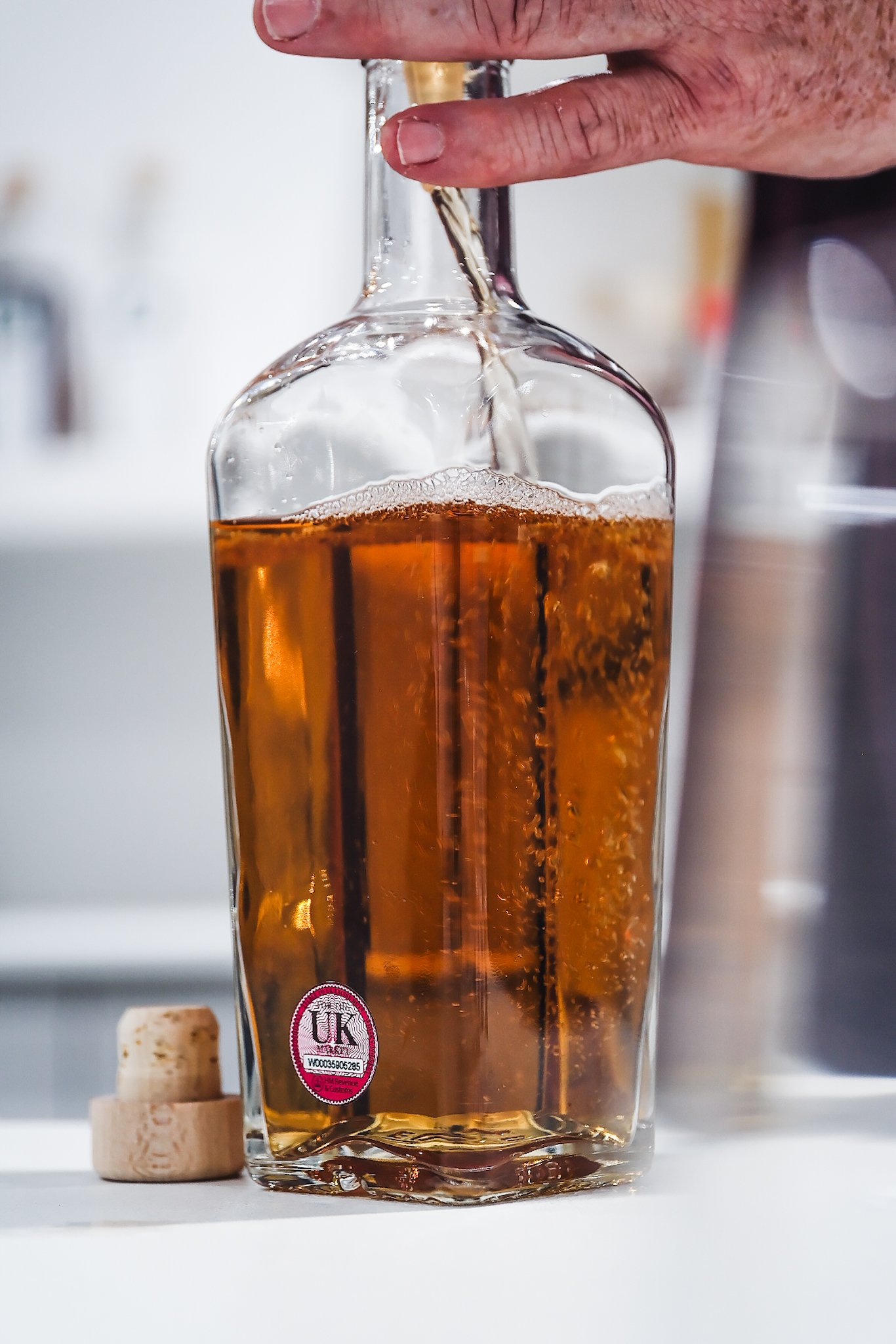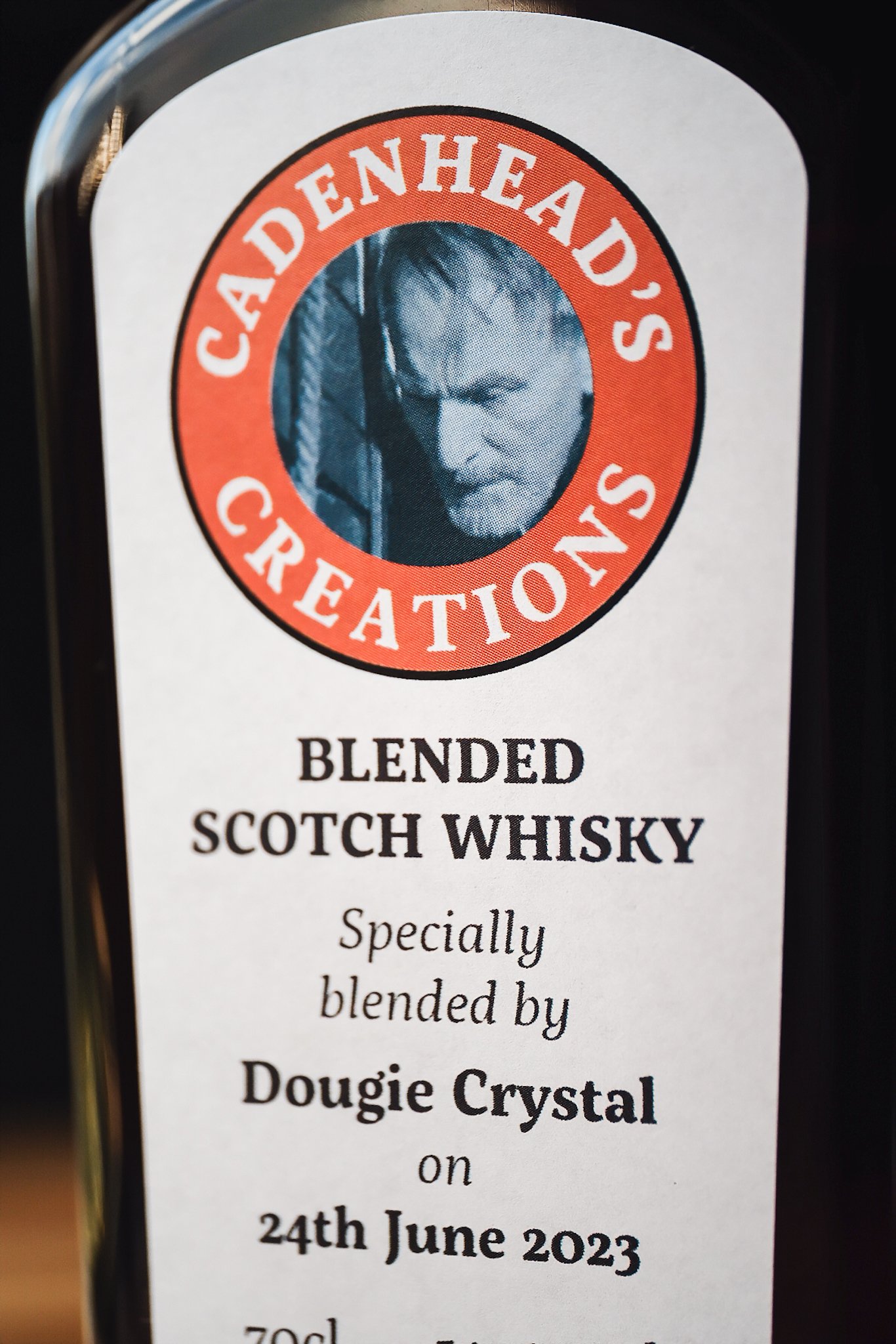Cadenhead’s Creations Blending Lab
Dougie’s Bottle | 54.53% ABV
Score: 9/10
Exceptional.
TL;DR
An eye-opening experience that we should all try, if only to show how hard it is
Blend your own whisky? I’m all in.
The Cadenhead’s shop in Campbeltown is full of whisky both incredible in variety, but also in value.
There are shelves lined with Cadenhead’s branded primo whisky of all price points, from £47 Tullibardine all the way up to £300 Jura. Not only that, but there’s a small corner section dedicated to other official bottlings from Glen Scotia, Ardnamurchan, Raasay, AnCnoc and many more. The last time I was in this shop was last year after our Warehouse Tasting tour, to buy the exclusive bottlings available only to those who joined this experience.
As we walked to the Springbank shop in the morning of our big day at the Wee Toon, having sailed over yesterday from Largs in my uncle’s sailboat, I glanced in the still shuttered Cadenhead’s shop window at what was on offer. Just the previous evening, having rafted to another boat owing to the lack of space in the marina and settled in with some drams, we’d been talking about Box whisky, the Swedish distillery that changed its name to High Coast in 2018. My uncle had been making his way through the Crinan Canal last year and got chatting with a Swedish couple who were doing the same. They’d given him a sample of Box whisky and he loved it, so when I saw it in the window I mentioned it to him.
After our shop visit and tour at Glengyle, we had lunch at the Cadenhead’s Tasting Room, where they now offer light bites and sandwich platters. We were parched and hungry by then, choosing the sandwich platters and litres of cooling water. It took an age to arrive and at one point I wondered if they’d run out of sandwich fillers and were frantically making up some more. Remorsefully my uncle’s arrived first on thick multigrain artisan bread, delicious looking and inviting. There must have been a half-loaf there easily, perfect for soaking up the upcoming whisky bout of blending bonanza. My belly was rumbling now.
A few minutes later mine arrived looking like a child’s lunchbox - pristine white sliced bread with crusts cut off. My uncle was at first amused, but then perplexed and finally upset on my behalf at this miscarriage of justice, but I was happy just to be getting solids into my facehole. The fillings were superb, and regardless of bread choice it was a mound of food, thus blending barrier boxes were being ticked. The biggest irk for my uncle stemmed from the fact that we were paying the same for both of these things, yet I had clearly, given the stark difference in presentation of our dishes, received a lesser deal. It turned out ok in the end - he couldn’t complete the half-loaf challenge so I reluctantly got in there and helped out.
The cosy climes of the Cadenhead’s Tasting Room
Fed and watered, we waltzed around the block to the main entrance of the shop. It was quiet inside but all the staff were really lovely - attentive and willing to give us samples of anything we wanted. I had an eye on a Dailuaine port cask and asked the guy for a sample, if he had it. In between that request and him finding an open bottle, Naimh appeared and announced that she would be hosting our Blending Lab experience today, and that we were the only two people signed up. My uncle asked where the High Coast was that I’d seen in the window, and how much they asked. £60 came the response and, after we had a wee plastic thimble of it, deemed it worthy and bought a bottle there and then. Seven year old Swedish single malt matured entirely in an American oak cask. What’s not to like - from the wee plastic sample it very much resembled American bourbon.
The chap had found the Dailuaine in the back office, and said he’d let me try it after our blending experience. With that, it was off into the lab behind the main shop. What a place it is too - pristine white from floor to ceiling, with cool lights and literally hundreds of vials of various amber liquid dotted about the place. It definitely felt like we were about to get down to some serious science.
A quick safety briefing (don’t race or you’ll get drunk), some light tips (don’t just chuck it all in there willy-nilly) and a final rule you can’t just single-cask it, requiring at least two bottles to be used, and we were down to business.
Review
Cadenhead’s Creations Blending Lab, 54.53% ABV
£100 per head
By bottles I mean little 250ml bottles that had been set aside neatly in rows on the countertop. These smaller bottles were filled from the larger glass demijohns sitting in the corner, which were also used to fill the eight test-tubes standing before us now. From these eight test tubes, marked A through H, we would create our masterpiece, with the first task getting some whisky into each of the eight Glencairns sitting atop a printed sheet with space for notes. Let the fun commence.
We had discussed our approaches on the way round to the shop and my angle of attack was to get the eight drams properly sussed out; nosed and tasted to within an inch of each life until I had a solid understanding of what every dram had, characteristically, so that I could then consider how best to bring some, or all, together into one cohesive whisky. Starting at “A” I noted brown sauce, earth and pepper on the nose, maple bacon and Campbeltown on the palate. So far, so ambiguous. “B” was really interesting with the first image flashing to mind being that of a foosty sandwich that I’d left in my school back for four weeks, before discovering it mid-Lego sesh to bouts of being sick and shouting. Bready, grainy, peanut M&Ms. Palate was “fishy”.
Test tube “C” was a beaut, clearly sherry cask with notes of Bakewell tart, fresh paper, cardboard bins - colour dull red. Nice, and I put a wee cross on the sheet to earmark it for what I supposed would be the base for my blend. “D” was similar with a bit of coastal coming through too, but the giveaway for me was a palate that resembled nail varnish - a sure sign of grain whisky.
“E” was salty, cardboard-like with pickles. I wrote “beach smelly” because it smelled like an old beach towel you’d forgotten to wash. Cardboard on the palate too…not my favourite. “F” was savoury, malty, salad with oven chips on the palate, “G” brought herbal, grass, wood, creaminess and more wood on the palate. Finally “H” was what I’d pretty much sussed out, owing to writing it on the sheet, as young Kilkerran. First notes “KK, vinegar chip poke - peaty/smoky. Palate = Kilkerran.”
Over and over we went around the glasses, smelling, thinking, chatting and noting, with my uncle shouting out his observations and me finding, or not, the same in the glass. He thought “E” was horrific - Germoline* all day long, and “who’d want that in their whisky?” Well, quite. Niamh sat around the corner laughing at our ridiculous chat, with gherkins and smelly towels, foosty sandwiches and Germoline. This is a new experience for Cadenhead’s and the request was made early on to feedback anything we thought worthwhile - throughout our time Naimh would appear and guide us along, asking pertinent questions and making sure we had enough of everything, from water to syringes and top ups of test tubes if required.
*Germoline is an antiseptic scented with wintergreen. Think root beer. Ed.
Eventually the time arrived to start bringing things together and a small beaker was available, as well as a “Perfect Measure” copita to try your blend, to make sure things were accurate. That and the syringe made it easy to measure out each component. My uncle’s approach was to use a big whack of base whisky with a few little nuanced touches from three other whiskies - four in total. His turned out quite light in colour, for he was trying to create a summery dram - bright, fresh, coastal, sweet and fruity. Mines was really dark by comparison, given that I’d opted to use the two sherry forward drams as base, then four other whiskies on top for kicks - six in total.
Blend now mixed in the beaker, I decanted it into the copita and left it for a second. Then nosed it - oh no. Sour. Something wasn’t right. What do I do? Knowing we were at crunch time, I rinsed my beaker with water and set about creating a slightly different, yet similar style whisky from the remaining levels in my test tubes. I thought it might have been the introduction of the pickled dram, “E”. Removing this from the equation and upping the so-called Kilkerran “H”, I sat it down to mingle and went back to the copita with my first attempt. Now it wasn’t sour, it was sweet. A good sniff revealed all that I like in a dram - coastal yet rich, decadent yet light. I tasted it and found it equally rewarding. Oh wow, this is tough.
By this point we’d both had a decent amount of whisky inside us, the dram of Kilkerran after our tour and then the tiny snifter of High Coast in the shop, followed by eight pours of 30-50ml (the test tubes weren’t marked). To say our wits were about us would be false. But it was time to finalise it all, so I gave my initial blend another final go - really like it - and then the beaker of my second attempt, just as good but I prefer the sweetness of the first. Done deal. Naimh appeared with a notebook ready to take down our quantities of each dram so that she could bring those 250ml bottles over from the counter ready for us to create our masterpiece.
Carefully tipping into the tall measuring flask each of our components, soon the impact of what we were doing sunk in - this is a unique, totally bespoke whisky created in this crazy place using totally blind whiskies and our abilities as whisky drinkers to decide what does, or doesn’t, make a good whisky. This is completely on us, if it’s a howler. There’s nobody to blame. We did the work. We chose the components. How hard it was to make decisions and how indecisive I became when the final nail was due to be struck.
Anyway, flasks fully filled we then poured it all, with horrific accuracy, into a clean 70cl bottle (and out on to the table) via a small plastic funnel. Eventually the whisky was inside and, after a wee check of the ABV using a fancy computer thingy, the stoppers were firmly pushed on with a squeaking finality. This was it - our very own whisky. Typically Naimh would then take mugshots using the tablet she held in her hand, which would then be stylised and printed onto the roundel on the label, but given auld Doog has his own wee avatar, I asked if we could place that on the label instead. A few emailing issues and network problems resolved, it was to be so - Auld Doog’s Blended Whisky was born.
The machine to place a nice wax seal on top was broken meaning Niamh had to run up to the Springbank shop to seal our bottles, so we were lead through a secret door back into the place where we had our lunch, and sat with the remaining measures from the eight test tubes in the lab discussing the experience - overwhelmingly fantastic was the sentiment. Such a great way to spend an afternoon. Not long after we’d sat down someone in the vicinity said: “Dougie?” I looked up to a face I didn’t recognise, but clearly he recognised me. “What makes you think that?” I said, half-cut and desperately trying to place a face to any name.
Turns out we’d just chatted over Instagram the day before about my plans for this experience, and his plans to travel up to Campbeltown from down south, in his camper van, for the weekend. A really lovely chap, he was stopping here first then driving up and around to Ardnamurchan distillery to try and snag one of the hand-fills, the same one I recently reviewed. Fantastic to spend a bit of time with him chatting about the beauty of whisky; he already knew someone that was sitting at the bar, who in the midst of our gabbing was handed a sample of the new Cadenhead’s Springbank 26yo in a glass, as thanks for all the times he’d handed bottles into the bar as gifts. We all smelled it, and decided it smelled good.
Returning from the Wee Toon I left my blended bottle sitting on the illuminated supershelf for two weeks before finally opening it - I wanted to give it time to settle and marry. If you’re interested in what the eight whiskies were that made up the blending set, I’ll tell you but only if you are not intending to do this experience anytime soon. It would ruin the fun if you knew even what region these whiskies came from - bias is so easy to accept, and so difficult to shake.
Score: 9/10
Exceptional.
TL;DR
An eye-opening experience that we should all try, if only to show how hard it is
Nose
Pepper, aniseed, candle wax, translucent red. Rounded. Dried fruit - raisins certainly. Bit of a coastal lick. Bit of earthy peat.
Palate
Follows the nose quite closely - a bit of a sherry forward blend. Dried fruits. Spices - cinnamon and maybe even turmeric - a peppery vegetal earthiness. Caramel pud - treacle tart. Bit of smoke, bit of sharp - slight pickle note. Savoury whiff - cereal. A bit of a salty thing going on here too.
The Dregs
Quality in, quality out. In May this year I decided, upon the completion of the Nickolls & Perks Ardnamurchan exclusive, to use the empty bottle to create my own Ardna Superblend. I used 50ml from select bottlings that appeared in the Ardnageddon review, as well as a few others that I’d acquired in the time since Christmas. That bottle, filled to 70cl and noted for components, was left for a month before I opened the stopper and poured the first dram. It was incredible. It was Ardnamurchan but… jazzed. The core range maritime toffee biscuit was there, but the various other things like the Paul Launois, Madeira Release, Little Brown Dog’s Banksy, April Fool and a few others had brought a huge amount of complexity to it too. Magnificent - quality in, quality out.
With Cadenhead's blending experience we have to assume that the whiskies going into our bottles are of high quality and stand-alone excellence, for even after the reveal of what each test tube held it was only a cask type, a region and an age - no specific distilleries. The main bulk of my blend was a Pedro Ximinez 10yo Highland - 300ml, and an oloroso 16yo Highland - 200ml. For someone that wasn’t into sherry casked whisky at the time, this doesn’t half buck that trend.
The whiskies that we nosed and sipped in the lab were all individual and excellent - not once did we think, say or feel that any one of the whiskies in our glass was of bad quality, smell or taste. Not to our individual preferences maybe, but nothing untoward and all whiskies used in our blend were cask strength. The final ABV of my bottle is, as you see, 54.53%. Quality in, quality out.
I say all that to say this - our job on the day was not as easy as you’d think, despite theoretically being simple: pick from any of the eight whiskies and bring them together to form something that I like - given how easy the Ardnamurchan Superblend was to make, surely this would follow on. Regardless of what went in, the blend here would at least resemble… something good?
The difficulty for me came when I had to take all the individual components that I had assessed and decide what elements I wanted in my whisky, and by how much. Having blended five infinity bottles now, I knew just how easy it is to sway the whole direction of that bottle by adding something nefarious. I had a beautiful infinity bottle going that was shaping up to be a stoater, and then I added in 50ml of Kilkerran hand-fill from last year and the whole bottle shifted to having an overtly gherkin finish. 50ml was all it took to destroy the subtleties of all the other whiskies in there. It’s even worse if you add peated whisky - it’s so easy to have one element dominate all others.
So when I look now at my component sheet I see that I’ve used a lump of sherried whisky to lay the path, and then dotted that path with little pips of influence - a port cask, a sauternes cask, a grain whisky and, what I’d decided was Kilkerran but turned out was a peated Islay cask - in small quantities to try and retain some semblance of balance to the whole thing. Have I succeeded? Is this a whisky that defies logic, that sings from the rooftops and forces me to apply for a role as master blender?
Sort of. No, and maybe. I succeeded in creating my own whisky made up of flavours I love in whisky - gingerbread toffee cake with lashings of chocolate, salt, rocks and a bit of smoke. It doesn’t defy logic or sing from the rooftops, but presents as a good whisky that has no foul notes and is moreish and lovely.
The more I dip into it the more I’ll find - whisky develops with exposure and time, and a wee bit of tightness will soon release to show me what other beauties lie within this liquid. What is clear is that the quality of whisky that we used to make up the blend is extremely high - no-one should worry that we’re using substandard whiskies here. Does it mean that I’ve crafted something that others could not? Am I now a master blender?
Absolutely not. If anything the Cadenhead’s Creations experience has only reinforced how absurdly difficult it is to blend whisky. Forget the palate fatigue, the head buzz and the slow inexorable yomp into jelly legs, just being able to identify and piece together components to make up a whisky is really hard work. The question that pins the tail on the donkey is: could I recreate the same whisky I made with totally different casks? I don’t think I could. I’d have to know my bottle inside out and possess the knowledge, palate, patience and wherewithal to work it out, and I just don’t have those skills.
It’s incredible that people like Dr. Rachel Barrie of Brown-Forman fame, Michael Henry at Loch Lomond, or in a more team-based scenario the five blenders at Ardnamurchan, are able to take matured casks of whisky and blend them together each year to make not just a quality whisky, but a whisky that matches all previous whiskies of that expression in smell and taste. Batch variation is a real thing, and the reason is both the variance of casks used and the skills of the blender to take those casks and bring them together to match, as near as possible, the character of that particular strain of whisky. GlenDronach 12yo went from unbelievable quality and value to something that was questioned for even existing - albeit shrouded in a strange blanket of tears surrounding their chill-filtration policies. We tried back to back examples of GD12 and found it was more than likely a batch variation.
Blending whisky is a genuine art form that demands maximum respect. It was incredibly fun and enlightening to try it myself, and I urge any of you that find themselves in the vicinity of Campbeltown to book yourselves into the Cadenhead's Creations Blending Lab experience. It’s a not inconsequential £100 entry fee, but for that price you get a one-off experience, spending an afternoon absorbing what it means to be a whisky blender. You get a one-off 70cl bottle of cask strength, high quality whisky with your face on the label. You get a wee Cadenhead’s copita glass, notebook and pen, your certificate of blending and breakdown of components. You get to walk through the hidden bookcase door and finish the remnants of the eight measures of whisky you used to make your blend.
And you expand your knowledge in whisky, admiring this beautiful amber spirit and what it means to us all. Quality in, quality out.
Back in the boat, admiring our achievements
A final note - the score for my bottle is not 9/10 - that would be ludicrous and silly. I can’t possibly comment on my own bottle and where it sits in the grand scheme of whiskies - that’s for someone else to do and, at some point, I’ll get one of the Dramface team to review it, just to see what they think of my job as a blender.
You can’t buy my bottle of whisky, and you won’t be able to recreate it, so the mark is for the experience alone - I genuinely think it’s something everyone who has a passing interest in whisky should try it - your view of whisky as a whole will be brighter as a result.
Thanks to Naimh for making our afternoon so fun, and the team at Cadenhead’s for creating such an enjoyable, welcoming experience.
Score: 9/10
Tried this? Share your thoughts in the comments below. DC
-
Dramface is free.
Its fierce independence and community-focused content is funded by that same community. We don’t do ads, sponsorships or paid-for content. If you like what we do you can support us by becoming a Dramface member for the price of a magazine.
However, if you’ve found a particular article valuable, you also have the option to make a direct donation to the writer, here: buy me a dram - you’d make their day. Thank you.
For more on Dramface and our funding read our about page here.
Other opinions on this:
Tried this experience? Share in the comments!
Got a link to a reliable review? Tell us.

